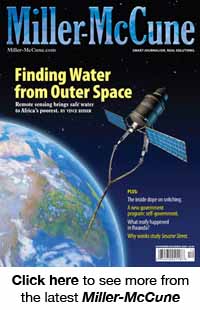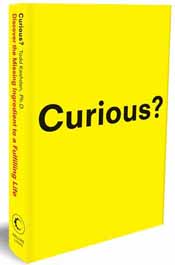Todd Kashdan has a deep appreciation of anxiety, which makes his engaging book Curious? unique among the comfort-promising volumes in the self-help section. For most of us, anxiety is a decidedly unpleasant emotion — one we strive to avert, either by avoiding situations that provoke apprehension, latching onto false but comforting certainties, or (my personal favorite) numbing out via our addiction of choice. Pointing out anxiety’s usefulness is akin to putting in a good word for pain.
But of course, it’s not the anxiety itself that causes problems but those dysfunctional coping mechanisms. As the George Mason University psychologist notes, anxiety is in fact one-half of a quite useful yin-yang process. Rather than resist it, he argues, we should acknowledge its existence and turn up the volume on the other side of the equation: the impulse that pulls us toward challenge and exploration.

That is to say, we need to cultivate curiosity.
“Our curiosity and threat detection systems evolved together, and they function to ensure optimal decisions are made in an unpredictable, uncertain world,” he writes. “We are all motivated by the pull toward safety and seek to avoid danger, but we also possess a fundamental motivation to expand and grow as human beings.”
Kashdan, who has conducted research on this topic for a decade, argues that curiosity and anxiety work together — one propelling us to explore, the other putting on the brakes so that we don’t take unwise risks. The problem, in his view, is that we have devalued curiosity, putting the bulk of our energy — as individuals, communities, nations — into anxiety avoidance.
“I think we have lost the balance,” he argues. “The environment has pulled us in the direction of having to constantly respond to our fears. A lot of people — especially in government — have realized fear is a useful motivating tool to get people to support whatever policies they want to push.”

He’s also wary about the notion of happiness as the ultimate goal of life. (Take that, Founding Fathers.) A meaningful life, he argues, is one of passion and engagement — of discovering what moves and inspires you at a deep level and then pursuing that passion.
But you’ll never find that sense of purpose without searching, which is where curiosity — and tolerance of a certain level of anxiety — comes in. The good news, Kashdan argues, is that curiosity can be cultivated, and once you start approaching the world from a standpoint of inquisitiveness, the brain reinforces this behavior by releasing dopamine. As he puts it: “We are hardwired to experience a rush of excitement when something novel and unpredictable breaks through the routine.”
While rather loosely structured, Curious? is a good read, a jargon-free summary of recent scientific research on happiness, anxiety and brain chemistry that gently nudges its readers to rethink the role anxiety plays in their lives. While it is focused on individual behavior, Kashdan’s research — and that of the other psychologists he incorporates — has intriguing public policy implications.
He argues that public health officials need to rethink their emphasis on scary pronouncements about pending pandemics. “When you activate their threat systems, people are not good at collecting or synthesizing information,” he notes. The government may have good information on how to prepare for a hurricane or the swine flu, but anxious people aren’t able to process it effectively. Presenting the information as something new and interesting — but not necessarily alarming — could be far more effective in actually influencing behavior.
Similarly, Kashdan believes environmentalists are wrong to try to frighten people into changing their lifestyles. “Scaring people may inspire them to do something for a week or two (which is why last-minute negative political ads are effective), but three weeks later, they’ll have returned to their old habits,” he says. “The research suggests the best way to have someone invested in, say, environmental sustainability is finding a way to link it to the person’s core values and interests.”
Employing Kashdan’s concepts in the classroom could result in radical changes. He envisions a less-structured educational environment in which students read books that actually engage them (perhaps volumes they choose themselves) and share what they’ve learned with the class. Rather than following a strict curriculum, teachers would let discussions flow freely, picking up on interesting observations and helping students to connect the dots.
This sort of free-form lesson plan might not improve scores on standardized tests, but Kashdan persuasively argues it would make the school day a lot more interesting for students and teachers alike. “We’re hyper-focused on surface content in our educational system,” he argues. “If you can’t develop self-control and tolerance for uncertainty, you’re not going to navigate life very effectively.”
At the other end of life, Kashdan quotes from recent research suggesting a mindset of continuing curiosity — of eagerness to learn new things — may stave off age-related cognitive decline. Rather than encouraging seniors to do crossword puzzles, he argues, we should be urging them to pursue new hobbies, read about new subjects, sample new dishes. It now appears that it’s novelty that keeps the neurons firing.
Most of us engage in what Kashdan calls passive curiosity. If something odd crosses our path (say, a dog dressed up as a punk rocker), we are interested in learning about it. But there’s novelty everywhere, and it’s very much worth seeking out. As evidence, Kashdan quotes a Gallup survey of 130,000 people from more than 130 nations. “The two factors that had the strongest influence on how much enjoyment a person experienced on a given day,” he notes, “were ‘being able to count on someone for help’ and ‘learned something yesterday.'”
Sign up for our free e-newsletter.
Are you on Facebook? Become our fan.
Follow us on Twitter.




